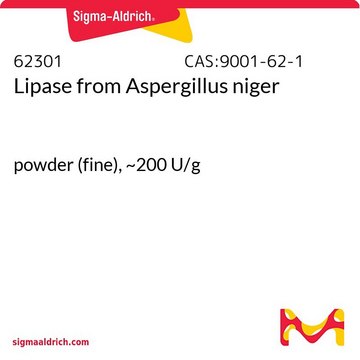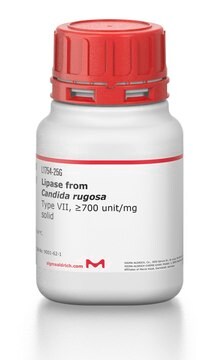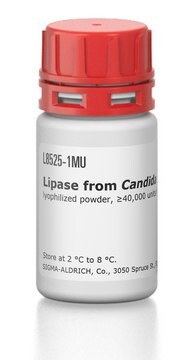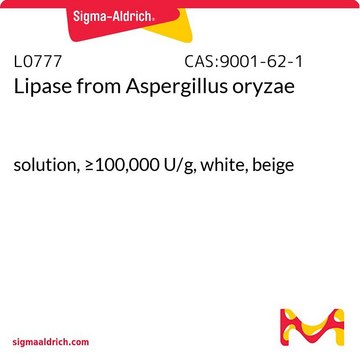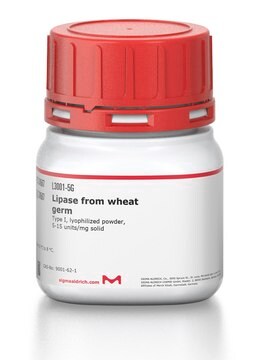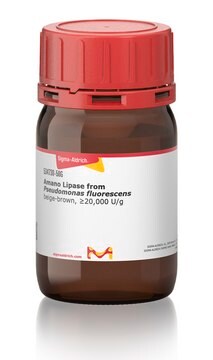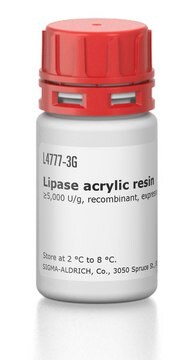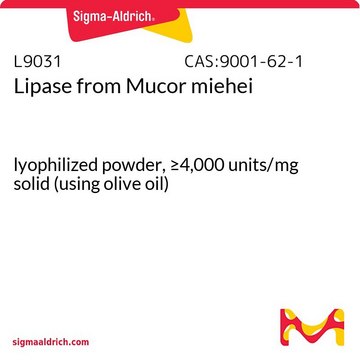62305
Lipase from Rhizopus oryzae
powder (fine), ~10 U/mg
Synonym(s):
Lipase from Rhizopus arrhizus, Triacylglycerol acylhydrolase, Triacylglycerol lipase
Sign Into View Organizational & Contract Pricing
All Photos(1)
About This Item
Recommended Products
form
powder (fine)
Quality Level
specific activity
~10 U/mg
mol wt
Mr ~43000
storage temp.
2-8°C
InChI
1S/C11H9N3O2.Na/c15-8-4-5-9(10(16)7-8)13-14-11-3-1-2-6-12-11;/h1-7,16H,(H,12,14);/q;+1/b13-9-;
InChI key
QWZUIMCIEOCSJF-CHHCPSLASA-N
Looking for similar products? Visit Product Comparison Guide
General description
Lipase from Rhizopus oryzae (ROL) comprises an oxyanion hole, four N-glycosylation sites, and an active site region. It possesses N-terminal presequence and prosequence.
Research Area: Cell Signaling
Rhizopus oryzae lipase (ROL) is a protein synthesized in a precursor form that includes a presequence of 26 amino acids, followed by a prosequence of 97 amino acids, which is attached to the N-terminal of a mature sequence consisting of 269 amino acids.
Rhizopus oryzae lipase (ROL) is a protein synthesized in a precursor form that includes a presequence of 26 amino acids, followed by a prosequence of 97 amino acids, which is attached to the N-terminal of a mature sequence consisting of 269 amino acids.
Application
Lipase from Rhizopus oryzae has been used:
- to test its effect on 1,2-diolein synthesis and triolein ethanolysis
- for immobilization on graphene oxide support for biocatalysis studies
- to digest triglycerides (TAG) from Chlamydomonas reinhardtii and S. cerevisiae
Lipases are used industrially for the resolution of chiral compounds and the transesterification production of biodiesel.
Biochem/physiol Actions
Rhizopus oryzae lipase (ROL) has been extensively researched for its regiospecificity in biodiesel production. Due to its remarkable characteristics, including 1,3-specificity, high enantioselectivity, and stability in organic solvents, ROL has garnered significant attention for applications in the energy, food, and pharmaceutical industries.
Lipase from Rhizopus oryzae (ROL) acts as a catalyst for the enzymatic biosynthesis of polyglycerol polyricinoleate through a reversal of hydrolysis. ROL is useful in the industrial production of structured lipids due to its 1,3-regiospecificity functionality.
Tri-, di-, and monoglycerides are hydrolyzed (in decreasing order of rate).
Lipases catalyze the hydrolysis of triacylglycerols into glycerol and free fatty acids.
Lipases catalyze the hydrolysis of triacylglycerols into glycerol and free fatty acids.
Unit Definition
1 U corresponds to the amount of enzyme which liberates 1 μmol of butyric acid per minute at pH 8.0 and 40°C (tributyrin, Cat. No. 91010 as substrate) 5000 U as described above are equivalent to ~1 U using triolein, Cat. No. 62314 as substrate, at pH 8.0 and 40°C
Other Notes
Note: When triacetin is used as substrate, the pH is 7.4. Incubation time: 60 minutes.
Catalyst for the interesterification of oils and fats; For removal of interfering triglycerides in the electroimmunoassay of apolipoprotein B; Racemic epoxy ester resolution through enantioselective enzymatic hydrolysis
Signal Word
Danger
Hazard Statements
Precautionary Statements
Hazard Classifications
Resp. Sens. 1
Storage Class Code
11 - Combustible Solids
WGK
WGK 1
Flash Point(F)
Not applicable
Flash Point(C)
Not applicable
Personal Protective Equipment
dust mask type N95 (US), Eyeshields, Gloves
Choose from one of the most recent versions:
Already Own This Product?
Find documentation for the products that you have recently purchased in the Document Library.
Customers Also Viewed
Electroimmunoassay of apolipoprotein B in triacylglycerol-rich serum.
P Laburre et al.
Clinical chemistry, 31(5), 787-787 (1985-05-01)
J.A. Laffitte et al.
Indian J. Chem. B, 32, 94-94 (1993)
T. Kim et al.
Enzyme and Microbial Technology, 11, 528-528 (1989)
Cristina Martin et al.
Biochemical engineering journal, 53(2), 216-222 (2011-01-25)
A novel miniaturized system has been developed for measuring protein-protein interactions in solution with high efficiency and speed, and minimal use of protein. A chromatographic monolith synthesized in a capillary is used in the method to make interaction measurements by
Yu-Cheng Lin et al.
The American journal of clinical nutrition, 99(4), 869-874 (2014-01-31)
A genome-wide association study identified variants in or near patatin-like phospholipase domain-containing-3 (PNPLA3), neurocan (NCAN), lysophospholipase-like 1 (LYPLAL1), glucokinase regulatory protein (GCKR), and protein phosphatase 1 regulatory subunit 3b (PPP1R3B) that were strongly associated with nonalcoholic fatty liver disease (NAFLD)
Our team of scientists has experience in all areas of research including Life Science, Material Science, Chemical Synthesis, Chromatography, Analytical and many others.
Contact Technical Service